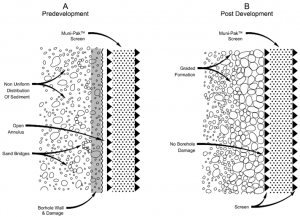We see many wells, including new ones, that are not performing as they should, with specific capacity and well efficiency much lower than they should be for the hydrogeological conditions. It can often be a bit of mystery why these wells do not perform as well as they should. Our experience has been that many times the answer lies with incomplete well development.
The well development process is an important part of establishing a well that produces at its maximum capacity, but can often be an afterthought during the well drilling and construction process. The process of well development is really just a series of techniques to repair borehole damage caused by the drilling, remove drilling mud and establish as clear a flow path for groundwater to move the well as possible. Well development can be as simple as using a surge block and air lift system to remove the drilling debris from the well, filter pack and surrounding formation, but drilling mud can be tricky to remove, especially when a significant volume gets lost into the formation, and it can require extra effort to recover it in those cases. Dispersants and chlorine can help with recovering bentonite based drilling mud out of the formation. Screen size, filter pack, formation characteristics and other factors all need to be accounted for when implementing effective well development.
Where well development can go wrong is with a lack of proper measurement techniques that should be spelled out in the drilling contract. Well development should continue beyond just obtaining clear water if there are still sanding or turbidity issues, if specific capacity is seeing improvement each time it is measured and if well efficiency is still showing improvement, as well. By having measurable standards for well development in the drilling contract, it becomes a “no negotiation” issue and the development process must continue until those standards are met.
Examples of measurement standards during well development can include:
Sand: Measure sand using a Rossum Sand Tester. Sand content shall average not more than 5 mg/L for a complete pumping cycle of 2-hour duration when pumping at the design-discharge capacity. No fewer than 10 measurements shall be taken at equal intervals to permit plotting of sand content as a function of time and production rate and to determine the average sand content for each cycle.
Turbidity: Turbidity should be measured using standard EPA methods. Turbidity should be less than 5 NTU at the completion of development.
Specific Capacity: Specific Capacity should be calculated during the development process. Development shall continue as long as the well’s specific capacity continues to increase significantly.
Well Efficiency: Well efficiency requires an observation well for reliable calculations. Well efficiency is calculated as the ratio of actual drawdown as measured in the well vs projected drawdown based on observation well data, as calculated on a semi-log scale. A well efficiency of 70-80 percent is considered to be an efficient well where well efficiency of below 60 percent indicates an impaired flow path to the well which can often be traced to well development or poor well design.
By having clearly measurable standards for well development in the drilling contract, it becomes a “no negotiation” issue and the development process must continue until those standards are met.


It’s great that you talked about how it’s important to consider a well’s capacity when building one. In a few months, my wife and I will start the construction project of our house. We’ve heard about the benefits of installing a water well, so we’re interested in getting one installed for our house. We appreciate your information about the importance of a water well development.
I’m glad you talked about the importance of having your new water well inspected. Recently, my wife and I decided to move into another home, and we’d like to make some improvements to it before moving in. We loved the idea of having our own water source, so we’ll be sure to look into it. Thanks for the information on water well development and its efficiency calculations.
It’s good to know that well drilling usually goes wrong because of poor measurement techniques. My dad was telling me about he wants a well in his backyard. So I’ll look for a company that is notorious for having a good measurement system.